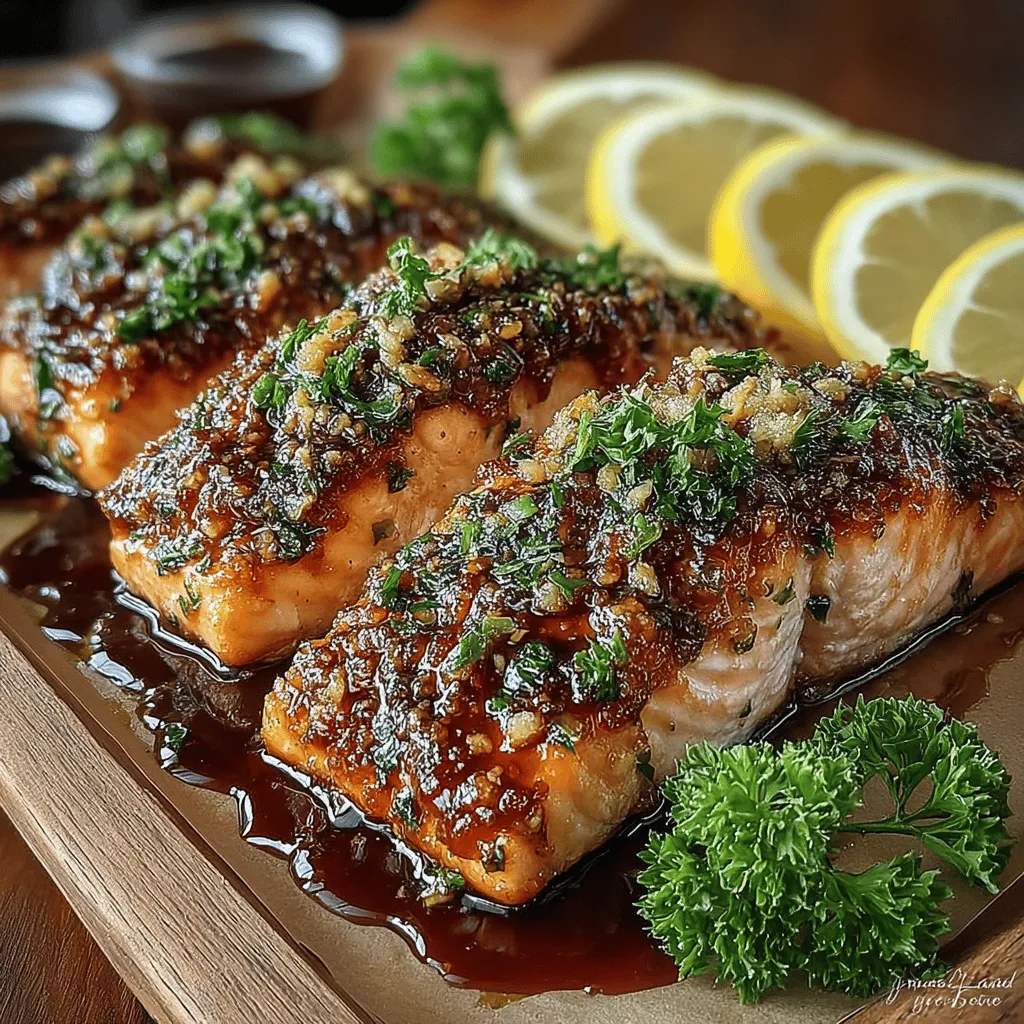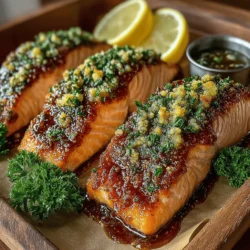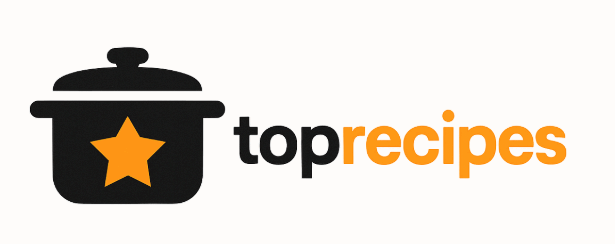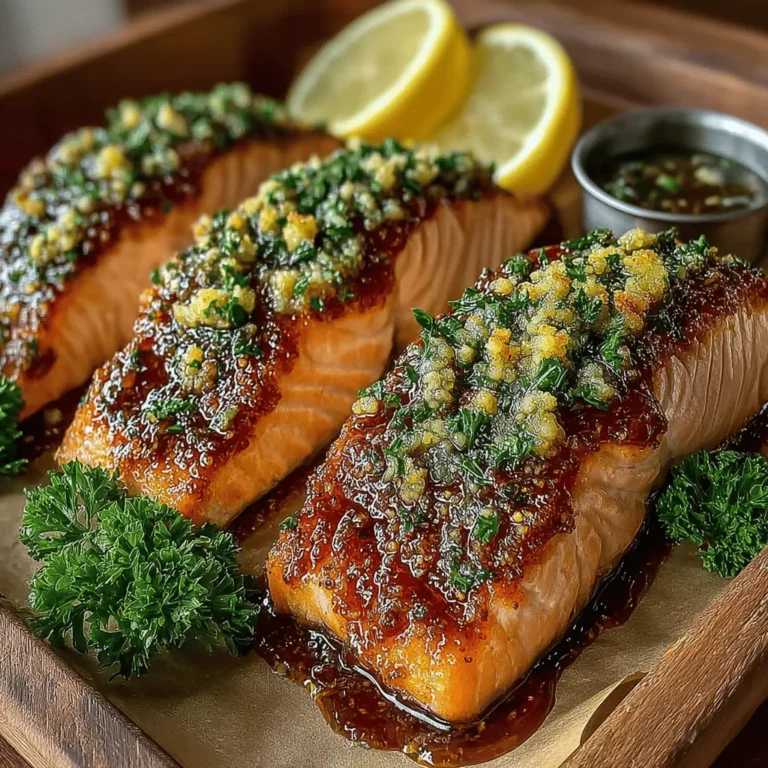Glazed Honey Mustard Baked Salmon is a delightful dish that perfectly balances sweet and savory flavors. The combination of honey and Dijon mustard creates a rich glaze that enhances the natural taste of the salmon, making it both flavorful and appealing. Salmon is not only delicious but also a fantastic source of nutrients, making it a great choice for a healthy meal. This recipe is easy to prepare and ideal for busy weeknights or special occasions.
Ingredients
– 4 salmon fillets (about 6 ounces each)
– 3 tablespoons Dijon mustard
– 3 tablespoons honey
– 2 tablespoons extra virgin olive oil
– 1 tablespoon soy sauce (or tamari for gluten-free)
– 2 cloves garlic, minced
– 1 teaspoon sea salt
– 1/2 teaspoon freshly ground black pepper
– Juice of 1 lemon
– Fresh parsley, chopped (for garnish)
Instructions
1. Preheat the oven to 375°F (190°C).
2. In a small bowl, whisk together Dijon mustard, honey, olive oil, soy sauce, minced garlic, sea salt, black pepper, and lemon juice until well combined.
3. Place the salmon fillets in a baking dish, skin side down.
4. Generously brush the honey mustard glaze over the salmon fillets, ensuring they are evenly coated.
5. Bake in the preheated oven for 15-20 minutes, or until the salmon flakes easily with a fork.
6. Remove from the oven and let it rest for a few minutes before serving.
7. Garnish with chopped parsley before serving.
Understanding Salmon and Its Health Benefits
Salmon is not just a delicious fish; it’s also packed with nutrients that are essential for maintaining good health.
Nutritional Profile of Salmon
Salmon is rich in high-quality protein, omega-3 fatty acids, and several important vitamins and minerals. A typical serving of salmon provides a significant amount of vitamin B12, selenium, and vitamin D, all crucial for optimal body function.
Health Advantages of Incorporating Salmon into Your Diet
Regular consumption of salmon can lead to numerous health benefits, including improved heart health, brain function, and reduced inflammation. The omega-3 fatty acids found in salmon are known to support cardiovascular health and may lower the risk of chronic diseases.
Sustainability Considerations in Choosing Salmon
When selecting salmon, it’s important to consider sustainability. Opting for wild-caught salmon over farmed varieties can help support healthier ecosystems and ensure that you’re consuming fish that are raised in a natural environment.
Ingredients Overview
Understanding each ingredient in this recipe enhances your cooking experience and allows for potential substitutions.
Salmon Fillets: Types and Selection Tips
When choosing salmon, you can typically find different types such as Atlantic, Sockeye, or Coho salmon. Look for fillets that are bright in color and have a fresh smell. Avoid any that appear dull or have an off-putting odor.
Dijon Mustard: Flavor Profile and Substitutes
Dijon mustard adds a tangy depth to the glaze. If you don’t have Dijon, yellow mustard can work in a pinch, though it will slightly alter the flavor profile.
Honey: Benefits and Alternatives
Honey not only adds sweetness but also has natural antibacterial properties. If you’re looking for alternatives, maple syrup or agave nectar can be used, but these will change the flavor slightly.
Extra Virgin Olive Oil: Health Benefits and Uses in Cooking
Extra virgin olive oil is a heart-healthy fat that adds richness to the glaze. Its antioxidants and healthy fats make it a great choice for cooking and dressing.
Soy Sauce: Role in Flavor Enhancement and Gluten-Free Options
Soy sauce enhances the umami flavor of the dish. For a gluten-free alternative, tamari sauce is a great substitute that provides a similar taste.
Garlic: Health Benefits and How It Complements the Dish
Garlic infuses the dish with a robust flavor and offers numerous health benefits, including immune support and anti-inflammatory properties.
Seasoning: Importance of Sea Salt and Freshly Ground Black Pepper
Using sea salt and freshly ground black pepper elevates the flavors of the salmon and glaze, ensuring a well-seasoned dish.
Lemon Juice: Its Role in Flavor Balance and Freshness
Lemon juice brightens the glaze, cutting through the sweetness and enhancing the overall flavor profile of the salmon.
Garnishing with Parsley: Adding Color and Nutrition
Chopped parsley not only adds a pop of color but also provides additional nutrients, making it a perfect finishing touch to your dish.

Preparing the Baking Sheet
Benefits of Using Parchment Paper
Using parchment paper on your baking sheet can significantly enhance your cooking experience. It prevents the salmon from sticking, making cleanup a breeze. Additionally, parchment paper ensures even cooking by providing a non-stick surface that promotes better heat distribution.
Crafting the Glaze
Step-by-Step Process for the Perfect Consistency
To achieve the ideal glaze for your salmon, start by combining honey and mustard in a bowl. Begin with equal parts of both ingredients, then adjust to taste. Whisk in a splash of soy sauce or lemon juice for added depth. The goal is to create a thick, syrupy consistency that will cling beautifully to the fish.
Importance of Mixing Thoroughly
Thorough mixing is crucial to ensure that the flavors meld together seamlessly. This not only enhances the taste but also ensures that every bite of salmon is infused with the delicious honey mustard flavor.
Arranging the Salmon
Tips for Optimal Spacing and Presentation
When placing the salmon fillets on the baking sheet, allow for some space between each piece. This promotes even cooking and helps the glaze caramelize beautifully. For an attractive presentation, consider placing the fillets skin-side down, as this showcases the vibrant color of the fish.
Glazing the Fillets
Techniques for Even Coverage
To achieve even coverage of the glaze, use a brush or spoon to apply it generously over the top of each fillet. Start from the center and work your way out to the edges, ensuring that the entire surface is coated. For an extra layer of flavor, consider glazing the salmon halfway through cooking.
Baking Time and Temperature
Ensuring Perfectly Cooked Salmon
Preheat your oven to 400°F (200°C) for optimal baking conditions. Place the glazed salmon in the oven and bake for about 12-15 minutes, depending on the thickness of the fillets. This temperature and time allow the fish to cook through while retaining moisture.
Indicators for Doneness
To determine if your salmon is done, look for a firm texture that flakes easily with a fork. The internal temperature should reach 145°F (63°C). Remove the salmon from the oven as soon as it reaches this temperature to prevent overcooking.
Serving Suggestions
How to Present the Dish Attractively
For an impressive presentation, serve the glazed salmon on a warm plate, garnished with fresh herbs like dill or parsley. Accompany the fish with lemon wedges for an added touch of brightness and acidity, which complements the rich flavors of the glaze.
Flavor Profiles and Pairing Suggestions
Analysis of the Sweet and Savory Balance
The honey mustard glaze combines sweetness from the honey with the tangy kick of mustard, creating a harmonious balance that enhances the natural flavors of the salmon. This sweet-savory profile makes it versatile for pairing with various sides.
Suggested Side Dishes that Complement Baked Salmon
To create a well-rounded meal, consider pairing your glazed salmon with roasted asparagus, sautéed spinach, or a refreshing salad. These options not only provide a color contrast but also add nutritional value.
Grains: Quinoa, Brown Rice, or Couscous Ideas
Serve your salmon alongside grains like quinoa, brown rice, or couscous to create a filling and nutritious meal. These grains soak up the glaze’s flavors, enhancing the overall dining experience.
Beverage Pairings
For a delightful beverage pairing, opt for a crisp white wine, such as Sauvignon Blanc or Chardonnay, which complements the dish’s rich flavors. Alternatively, a light herbal tea or sparkling water with lemon can enhance the meal without overpowering it.
Storage and Reheating Tips
Best Practices for Storing Leftovers
To store leftover glazed salmon, allow it to cool completely before transferring it to an airtight container. It can be refrigerated for up to three days, ensuring that you can enjoy the flavors of this dish for meals throughout the week.
How to Reheat Salmon Without Losing Flavor or Texture
To reheat your salmon, place it in a preheated oven at 325°F (163°C) for about 10 minutes, or until warmed through. Avoid microwaving, as this can dry out the fish and compromise its texture.
Ideas for Repurposing Leftover Salmon
Leftover salmon can be creatively repurposed in various dishes. Consider flaking it into a salad, mixing it into a grain bowl, or using it in a creamy pasta dish. This allows you to enjoy the flavors in new and exciting ways.
Conclusion
The Glazed Honey Mustard Baked Salmon recipe is not only easy to prepare but also delivers a delicious and healthy meal option. With its sweet-savory glaze and versatility, it’s an excellent choice for family dinners or entertaining guests. We encourage you to explore cooking with salmon at home and experience the myriad of flavors and health benefits it offers. This dish is sure to become a favorite in your culinary repertoire.


